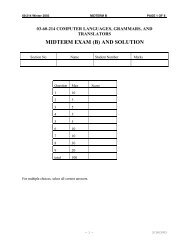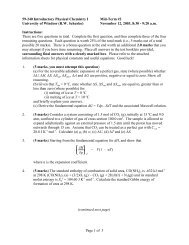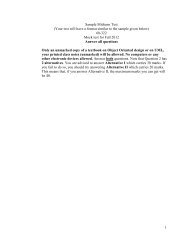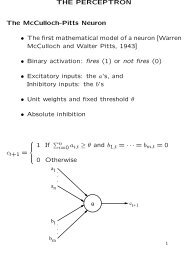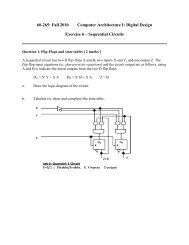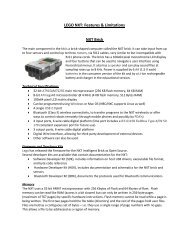FINAL EXAMINATION
FINAL EXAMINATION
FINAL EXAMINATION
Create successful ePaper yourself
Turn your PDF publications into a flip-book with our unique Google optimized e-Paper software.
MIDTERM <strong>EXAMINATION</strong> #1<br />
OPERATING SYSTEM CONCEPTS<br />
03-60-367-01<br />
U N I V E R S I T Y O F W I N D S O R<br />
S C H O O L O F C O M P U T E R S C I E N C E<br />
Intersession 2008<br />
Last Name:<br />
First Name:<br />
Student ID:<br />
PLEASE READ CAREFULLY BEFORE YOU START<br />
1. This is a CLOSED book test; no notes, textbooks, calculators or<br />
computer aids are allowed.<br />
2. PRINT your name legibly and clearly with your Student ID in the<br />
space indicated above.<br />
3. You will be asked to sign your name once before leaving the exam<br />
room (sign-out). You must also sign and return this examination<br />
paper.<br />
4. PLACE ANSWERS on Scantron sheet provided. DO NOT REMOVE<br />
any pages or attach any papers to this test or you will void your test<br />
and receive a mark of zero. If you need more space for rough work<br />
you may use any additional space on the examination paper.<br />
5. You are not allowed to give or receive unauthorized help with your<br />
test. Any misconduct, as outlined by the Senate bylaw 31 article I,<br />
will be reported accordingly.<br />
6. You have 65 minutes to complete this test.<br />
7. Midterm examination papers will be returned to students.<br />
TOTAL MARK:<br />
Good Luck!<br />
I AGREE TO THE ABOVE TERMS AND WILL NEITHER RECEIVE<br />
NOR GIVE UNAUTHORIZED HELP ON THIS EXAM<br />
/60<br />
SIGNATURE<br />
DATE<br />
SIGN HERE<br />
© 2008 by Dr. R. Kent – All Rights Reserved. No part of this document may be reproduced without written author permission. Page 1 of 10
All questions are either Multiple Choice or True-False. For each Multiple Choice question, you are<br />
to choose only one response which best answers the question. For True-False questions you may<br />
only choose one option (True or False).<br />
Place all responses on the Scantron sheet provided. In each case, be sure to carefully check<br />
the question number on both this examination paper and also the Scantron sheet. Completely fill in<br />
the circular area on the Scantron sheet, once again making sure to choose the correct circle<br />
corresponding to the examination question responses provided.<br />
If an error is made you must carefully and completely erase the incorrect circular area on the<br />
Scantron sheet, then completely fill in the corrected circle you have selected.<br />
_________________________________________________________________________<br />
1. A user requests a Web page that consists of some text and two images. For this page,<br />
the client will send one request message and receive three response messages.<br />
A) True<br />
B) False<br />
2. The Internet may be defined as many hosts running network applications interconnected<br />
with an infrastructure consisting of communication links and routers.<br />
A) True<br />
B) False<br />
3. The IETF is responsible for __________ .<br />
A) creating new Internet protocols<br />
B) ensuring that the Internet is operating correctly<br />
C) approving new Internet Service Providers<br />
D) setting Internet standards<br />
4. The Internet is described as being __________ hierarchical.<br />
A) strictly<br />
B) loosely<br />
C) non-<br />
D) completely<br />
5. Internet protocols define __________ .<br />
A) format of messages<br />
B) actions taken on message transmission and receipt<br />
C) order of messages sent and received among network entities<br />
D) All of these responses are correct<br />
6. All communication activity in the Internet is governed by protocols.<br />
A) True<br />
B) False<br />
© 2008 by Dr. R. Kent – All Rights Reserved. No part of this document may be reproduced without written author permission. Page 2 of 10
7. Interconnected routers in the Internet exist __________ .<br />
A) within access networks<br />
B) in the network core, as a network of networks<br />
C) on the network edge<br />
D) None of these responses is correct<br />
8. End systems, or hosts, communicate with each other using either server or client<br />
models.<br />
A) True<br />
B) False<br />
9. End systems must be connected to a(n) __________ in order to connect to an edge<br />
router.<br />
A) residential access network<br />
B) mobile access network<br />
C) institutional access network<br />
D) All of these responses are correct<br />
10. Circuit switching is used to establish dedicated network paths that may be shared by<br />
other end systems.<br />
A) True<br />
B) False<br />
11. Time and frequency division multiplexing schemes are used to divide link bandwidth<br />
into separately allocatable pieces.<br />
A) True<br />
B) False<br />
12. Packet switching in the network core inevitable leads to _____________ .<br />
A) bandwidth subdivision<br />
B) packet loss<br />
C) shared circuit switching<br />
D) resource contention<br />
13. In packet switched networks, store and forward refers to: ______________ .<br />
A) entire message must arrive at router before it can be transmitted on next link<br />
B) scheduling of packets to avoid congestion<br />
C) entire packet must arrive at router before it can be transmitted on next link<br />
D) entire packet must be stored on router until acknowledgement received<br />
© 2008 by Dr. R. Kent – All Rights Reserved. No part of this document may be reproduced without written author permission. Page 3 of 10
14. Packet loss occurs when the packet arrival rate to a link exceeds the output link<br />
capacity.<br />
A) True<br />
B) False<br />
15. Packet delay may be caused by ______________ .<br />
A) time required for nodal processing requirements<br />
B) time required for queueing<br />
C) transmission and propagation times<br />
D) All of these responses are correct.<br />
16. The Traceroute program provides a measurement of delay from source to router along<br />
an end-to-end Internet path towards the destination.<br />
A) True<br />
B) False<br />
17. Packet loss ______________ .<br />
A) may be dealt with by retransmitting packets, or ignoring them completely<br />
B) may be reduced or eliminated by expanding hardware buffers<br />
C) Both A and B responses are correct.<br />
D) None of these responses is correct.<br />
18. End-to-end throughput is most affected by ______________ .<br />
A) congestion delays<br />
B) buffer sizes<br />
C) bottleneck links<br />
D) All of these responses are correct.<br />
19. Two distinct document references (for example, cs.uwindsor.ca/60-367/index.html and<br />
cs.uwindsor.ca/60-367/outline.doc) can be sent over the same persistent connection.<br />
A) True<br />
B) False<br />
20. With non-persistent connections between browser and origin server, it is possible for a<br />
single TCP segment to carry two distinct HTTP request messages.<br />
A) True<br />
B) False<br />
© 2008 by Dr. R. Kent – All Rights Reserved. No part of this document may be reproduced without written author permission. Page 4 of 10
21. Consider an HTTP client that wants to retrieve a Web document at a given URL. The<br />
IP address of the HTTP server is initially unknown. What application layer protocols<br />
besides HTTP are needed in this scenario<br />
A) DNS and HTTP<br />
B) TCP for DNS; TCP for HTTP<br />
C) UDP for DNS; TCP for HTTP<br />
D) All of the above are correct responses.<br />
22. Consider an HTTP client that wants to retrieve a Web document at a given URL. The<br />
IP address of the HTTP server is initially unknown. What transport layer protocols<br />
besides HTTP are needed in this scenario<br />
A) DNS and HTTP<br />
B) TCP for DNS; TCP for HTTP<br />
C) UDP for DNS; TCP for HTTP<br />
D) All of the above are correct responses.<br />
23. Which of the following is not a proper layer of the TCP stack<br />
A) Link<br />
B) Network<br />
C) Session<br />
D) Transport<br />
24. Which of the following is not a proper layer of the OSI stack<br />
A) Propagation<br />
B) Network<br />
C) Session<br />
D) Link<br />
25. UDP and TCP are reliable protocols.<br />
A) True<br />
B) False<br />
26. Most local area networks use electrostatic network hardware.<br />
A) True<br />
B) False<br />
27. A network’s speed is expressed in terms of ____________ .<br />
A) Routing protocol<br />
B) Round trip time<br />
C) Bit rate and latency<br />
D) I/O buffer response<br />
© 2008 by Dr. R. Kent – All Rights Reserved. No part of this document may be reproduced without written author permission. Page 5 of 10
28. Photonic networks utilize ____________ switches.<br />
A) LAN<br />
B) IP<br />
C) CBR<br />
D) ATM<br />
29. TCP abstracts data communication to appear as an apparent stream of flowing data.<br />
A) True<br />
B) False<br />
30. TCP can process incoming packets that arrive out of order since packets are numbered.<br />
A) True<br />
B) False<br />
31. Both UDP and TCP require that the applications recognize their own data formats.<br />
A) True<br />
B) False<br />
32. Transfer across TCP streams is full duplex.<br />
A) True<br />
B) False<br />
33. Using TCP, two messages are exchanged before a connection exists.<br />
A) True<br />
B) False<br />
34. Multiple TCP streams can distinguished on a given machine using __________ .<br />
A) ports<br />
B) IP addresses<br />
C) network interface cards<br />
D) All of the above responses are correct.<br />
35. A machine (and even a single program) may have several open sockets at any time.<br />
A) True<br />
B) False<br />
36. All datagrams contain 2 ports.<br />
A) True<br />
B) False<br />
© 2008 by Dr. R. Kent – All Rights Reserved. No part of this document may be reproduced without written author permission. Page 6 of 10
37. Message encapsulation refers to __________ .<br />
A) designating message contents with descriptive data<br />
B) allowing for message content verification<br />
C) reliance upon IP for transmitting messages<br />
D) embedding message payloads and protocol headers within logically layered<br />
packages<br />
38. UDP and TCP are examples of ________ layer protocols.<br />
A) Application<br />
B) Presentation<br />
C) Transport<br />
D) Network<br />
39. Transport services and protocols ______________ .<br />
A) provide logical communication between app processes running on different hosts<br />
B) are provided in end systems<br />
C) make more than one transport protocol available to applications<br />
D) All of the above responses are correct<br />
40. Applications require which of the following transport services.<br />
A) Data loss and Security<br />
B) Timing<br />
C) Throughput<br />
D) All of the above responses are correct<br />
41. HTTP is referred to as a stateless protocol because _____________ .<br />
A) clients do not maintain historic information about transactions with servers<br />
B) servers and clients do not maintain open connections<br />
C) server maintains no information about past client requests<br />
D) All of the above responses are correct<br />
42. Cookies may be used to maintain user-server state.<br />
A) True<br />
B) False<br />
43. By using Web caching ______________ .<br />
A) it is possible to reduce response time for client request<br />
B) it is possible to reduce traffic on an institution’s access link<br />
C) the cache acts as both client and server<br />
D) All of the above responses are correct<br />
© 2008 by Dr. R. Kent – All Rights Reserved. No part of this document may be reproduced without written author permission. Page 7 of 10
44. Delivery and storage of email messages to a server is achieved using ___________ .<br />
A) Post Office Protocol (POP)<br />
B) Internet Mail Access Protocol (IMAP)<br />
C) Simple Mail Transfer Protocol (SMTP)<br />
D) Hypertext Transfer Protocol (HTTP)<br />
45. All forms of Peer-to-Peer systems are able to avoid using “always on” servers.<br />
A) True<br />
B) False<br />
46. Peer-to-Peer networks are used ____________ .<br />
A) for content file sharing<br />
B) for Instant Messaging<br />
C) for IP based telephony<br />
D) All of the above responses are correct.<br />
47. Domain Name System (DNS) is an application-layer protocol where host, routers and<br />
name servers communicate to resolve names (that is, provide address/name translation).<br />
A) True<br />
B) False<br />
48. Domain Name System (DNS) services are required to _____________ .<br />
A) permit aliasing of host names<br />
B) translate canonical names to IP address formats<br />
C) permit aliasing of email servers<br />
D) All of these responses are correct.<br />
49. Centralization of DNS services is considered to be a poor design approach because<br />
_____________ .<br />
A) it requires a distributed database<br />
B) it is costly to maintain<br />
C) it does not scale<br />
D) All of these responses are correct.<br />
50. Host A is sending Host B a large file over a TCP connection. Assume Host B has no<br />
data to send Host A. Host B will not send acknowledgments to host A, because Host B<br />
cannot piggyback the acknowledgments on data.<br />
A) True<br />
B) False<br />
© 2008 by Dr. R. Kent – All Rights Reserved. No part of this document may be reproduced without written author permission. Page 8 of 10
51. A server that is responsible for country domains, such as uk, fr, ca, jp and so, is called a<br />
_____________ .<br />
A) POP server<br />
B) authoritative domain server<br />
C) top level domain server<br />
D) DNS server<br />
52. A promising approach to solving the problem of query flooding on P2P networks is the<br />
use of _____________ to limit query forwarding.<br />
A) logical overlay networks<br />
B) circuit based switching emulated on top of packet switching<br />
C) load balancing<br />
D) index servers<br />
53. Public domain protocols _____________ .<br />
A) allow for interoperability<br />
B) are defined in RFC’s<br />
C) Both A and B responses are correct.<br />
D) None of these responses are correct.<br />
54. TCP flow control _____________ .<br />
A) stops senders from overwhelming receivers<br />
B) determines the reliability of message transmission<br />
C) Provides minimum guarantees of service<br />
D) throttles the sender when the network is overloaded<br />
55. UDP service does require connection setup and provides congestion control.<br />
A) True<br />
B) False<br />
56. Suppose Host A wants to send a large file to Host B. The path from Host A to Host B<br />
has three links, of rates R1 = 500 kbps, R2 = 2 Mbps and R3 = 1 Mbps. Assuming no<br />
other traffic in the network, what is the throughput for the file transfer.<br />
A) 500 kbps<br />
B) 2 Mbps<br />
C) 1 Mbps<br />
D) 1.67 Mbps<br />
© 2008 by Dr. R. Kent – All Rights Reserved. No part of this document may be reproduced without written author permission. Page 9 of 10
57. The BitTorrent application defines torrent as _____________ .<br />
A) the tracking of peers participating in torrent<br />
B) the speed of delivery of file chunks to requesters<br />
C) a group of peers exchanging chunks of a file<br />
D) the indexing of file chunk locations for speedy retrieval<br />
58. The client upload rate for P2P versus Client-Server approaches is essentially _______ .<br />
A) N<br />
B) Log 2 (N)<br />
C) N 2<br />
D) None of these responses are correct.<br />
59. Skype uses a proprietary application protocol.<br />
A) True<br />
B) False<br />
60. DNS resource records are stored in the tuple (name, value, type, ttl). If<br />
type=”CNAME”, it means that name refers to ___________ .<br />
A) the real name for some alias name<br />
B) the alias name for some canonical name<br />
C) the canonical name for some alias name<br />
D) None of these responses are correct.<br />
© 2008 by Dr. R. Kent – All Rights Reserved. No part of this document may be reproduced without written author permission. Page 10 of 10







